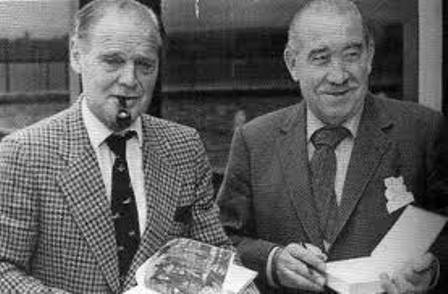Sir Douglas Bader, the RAF fighter pilot without legs.

Douglas Bader 
 was born in London in 1910. Douglas won a scholarship to St Edward’s School in Oxford. Followed by a place to the RAF College in Cranwell where he captained the Rugby team and was a champion boxer.
was born in London in 1910. Douglas won a scholarship to St Edward’s School in Oxford. Followed by a place to the RAF College in Cranwell where he captained the Rugby team and was a champion boxer.
Douglas was commissioned as an officer in the Royal Air Force in 1930 but after only 18 months he crashed his aeroplane and became a double amputee caused by “my own fault” in an aeroplane accident in 1931. While attempting some aerobatics, he crashed and lost both his legs.  Having been on the brink of death, he recovered, retook flight training, passed his check flights and then requested reactivation as a pilot. As a consequence of the accident Douglas was discharged from the RAF. He found work with the Asiatic Petroleum Company.
Having been on the brink of death, he recovered, retook flight training, passed his check flights and then requested reactivation as a pilot. As a consequence of the accident Douglas was discharged from the RAF. He found work with the Asiatic Petroleum Company.
In August 1941, Bader bailed out over German occupied France and was captured. Soon afterward, he met and was befriended by Adolf Galland, a prominent German fighter ace. 

 Despite his disability, Bader made a number of escape attempts and was eventually sent to the prisoner of war camp at Colditz Castle
Despite his disability, Bader made a number of escape attempts and was eventually sent to the prisoner of war camp at Colditz Castle 
 . He remained there until April 1945 when the camp was liberated by the First United States Army.
. He remained there until April 1945 when the camp was liberated by the First United States Army.
After the outbreak of the Second World War Douglas rejoined the RAF. Douglas was a member of No. 222 Squadron RAF  and was promoted to lead No. 242 Squadron RAF.
and was promoted to lead No. 242 Squadron RAF. 
His skill as an aviator and contribution as an outstanding leader and fighter ace during WW2, along with his continuous attempts to escape prisoner of war camp after he was shot down, was immortalised in the book and film ‘Reach for the Sky‘.
On returning to England Douglas was promoted to group captain. He left the RAF in 1946.
Having suffered a double disfigurement Douglas became an inspiration to disabled and able-bodied alike by demonstrating the ability to “get on with your life”. Post war found him working for Shell, getting his golf handicap down to an extraordinary 2 and fund raising on behalf of many disabled groups and charities.
Douglas Bader was honoured in 1976 with a Knighthood  for his contribution and work on behalf of the disabled community. Bader died of a heart attack age 72 on 05-09-1982 in Chiswick, london. and he is cremated.
for his contribution and work on behalf of the disabled community. Bader died of a heart attack age 72 on 05-09-1982 in Chiswick, london. and he is cremated.












Leave a Reply